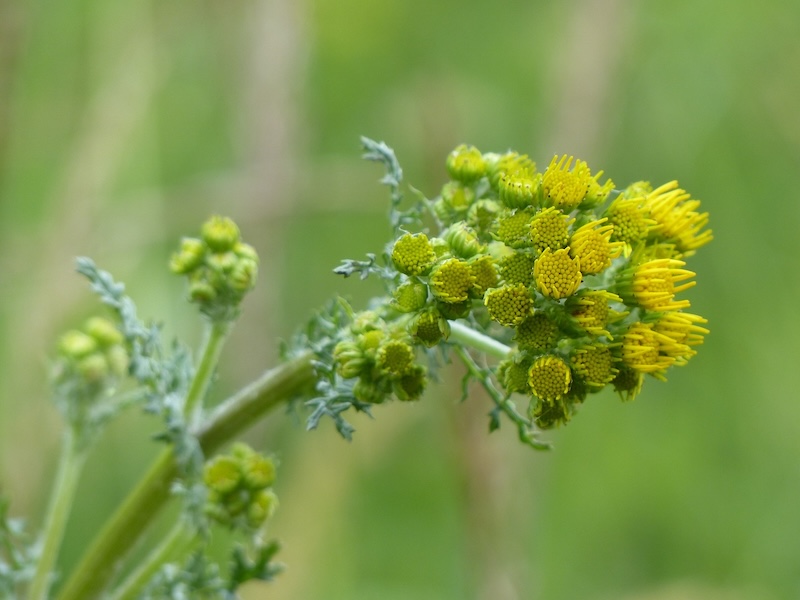Houseplants referred to as senecios are succulents and fall under the genuses Senecio and Curio. Some of the most popular senecios include string of pearls, string of bananas, and string of hearts. These plants cause mild to severely toxic reactions when humans or pets ingest small amounts. A few outdoor senecios native to North America are quite toxic and can be deadly when grazed by livestock or pets. These low-growing plants, including Senecio spartioides and Senecio jacobaea, are known by the common name tansy ragwort or groundsel.

Is Senecio Poisonous to Children?
Senecio houseplants are mildly toxic to young children and can cause either digestive upset or skin irritation. The sap of the stems and modified leaves will cause contact dermatitis on sensitive skin. Children who have ingested any amount of the plant should be seen as soon as possible by a doctor to determine a course of treatment.
Is Senecio Poisonous to Dogs?
Senecio is toxic to dogs and should be kept away from pets, young and old. The stems are brittle and can easily break off, so hanging baskets should be kept out of rooms frequented by dogs and children. Signs of ingestion include abdominal pain, contact irritation of the mouth, vomiting, rubbing of the face, loss of appetite, drooling, and distended stomach and bloating. If you suspect your dog has eaten senecio, call your veterinarian as soon as possible and bring a sample of the plant for proper identification.
Is Senecio Poisonous to Cats?
Cats may have extreme reactions to eating any part of a senecio plant. The plants contain alkaloid chemicals that may cause skin irritation, contact dermatitis, upset stomach, and possibly liver damage or worse if the animal is not treated as soon as possible. Signs of ingestion include vomiting, diarrhea, drooling, reduced attention to regular grooming, excessive sleeping, or hiding.
Is Senecio Poisonous to Other Animals?
The houseplants commonly known as senecio are toxic to other small pets such as guinea pigs, hamsters, rabbits, and ferrets. Keeping the plants away from these pets is the best way to ensure that no parts of the plant are eaten.
Larger pets and livestock may encounter the highly toxic meadow plant Senecio spp, known commonly as groundsel or tansy ragwort. This is a common weed in most of North America and is easily spread to grazing pastures on the wind. The dried plant is sometimes found in bales of hay and is as toxic as the living plant. Repeated grazing on senecio will cause liver damage and eventual death to most livestock. Goats and sheep are less affected than other animals, although long-term damage can result if the animals continue to graze the plants.
Symptoms Of Senecio Poisoning
Contact your family doctor or veterinarian if any of the following symptoms occur, or if you suspect that senecio has been eaten in any amount.
Here are some common symptoms to look out for:
- Vomiting
- Diarrhea
- Stomach upset
- Contact dermatitis
- Rash on the mouth or skin
Preventing Senecio Poisoning
The easiest way to prevent poisoning by a toxic plant is to grow it in an area off limits to pets and children. Placing the plants on a high shelf or in a hanging basket out of reach will reduce the risk of ingestion. Be careful when watering and working around senecio. Their brittle stems are easily broken and could fall where children or pets play. Curious climbers like ferrets and cats make it difficult to grow senecios safely no matter where the plant is placed.

Pet Poison Helpline
If something were to happen to your furry friend, and you suspect that they are suffering from senecio poisoning, there is a poison control hotline to call for 24/7 vet advice. It is called the Pet Poison Hotline, and their phone number is (855) 764-7661.
Sources:
"Senecio, groundsel, tansy ragwort." Colorado State University - Guide to Poisonous Plants. poisonousplants.cvmbs.colostate.edu
Johnson, A.E., Molyneux, R.J., and M.H. Ralphs. "Senecio: A Dangerous Plant for Man and Beast." Rangelands. 11(6), December 1989.
 |
Author Robbin Small - Published 12-21-2023 |
